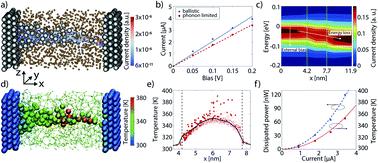当前位置:
X-MOL 学术
›
Nanoscale Adv.
›
论文详情
Our official English website, www.x-mol.net, welcomes your
feedback! (Note: you will need to create a separate account there.)
Electro-thermal transport in disordered nanostructures: a modeling perspective
Nanoscale Advances ( IF 4.6 ) Pub Date : 2020-05-19 , DOI: 10.1039/d0na00168f Fabian Ducry 1 , Jan Aeschlimann 1 , Mathieu Luisier 1
Nanoscale Advances ( IF 4.6 ) Pub Date : 2020-05-19 , DOI: 10.1039/d0na00168f Fabian Ducry 1 , Jan Aeschlimann 1 , Mathieu Luisier 1
Affiliation

|
Following the emergence of novel classes of atomic systems with amorphous active regions, device simulations had to rapidly evolve to devise strategies to account for the influence of disordered phases, defects, and interfaces into its core physical models. We review here how molecular dynamics and quantum transport can be combined to shed light on the performance of, for example, conductive bridging random access memories (CBRAM), a type of non-volatile memory. In particular, we show that electro-thermal effects play a critical role in such devices and therefore present a method based on density functional theory and the non-equilibrium Green’s function formalism to accurately describe them. Three CBRAM configurations are investigated to illustrate the functionality of the proposed modeling approach.
中文翻译:

无序纳米结构中的电热传输:建模视角
随着具有非晶活性区域的新型原子系统的出现,器件模拟必须迅速发展,以设计策略来解释无序相、缺陷和界面对其核心物理模型的影响。我们在此回顾如何将分子动力学和量子传输结合起来,以揭示导电桥接随机存取存储器(CBRAM)(一种非易失性存储器)等的性能。特别是,我们表明电热效应在此类器件中起着至关重要的作用,因此提出了一种基于密度泛函理论和非平衡格林函数形式主义的方法来准确描述它们。研究了三种 CBRAM 配置以说明所提出的建模方法的功能。
更新日期:2020-07-14
中文翻译:

无序纳米结构中的电热传输:建模视角
随着具有非晶活性区域的新型原子系统的出现,器件模拟必须迅速发展,以设计策略来解释无序相、缺陷和界面对其核心物理模型的影响。我们在此回顾如何将分子动力学和量子传输结合起来,以揭示导电桥接随机存取存储器(CBRAM)(一种非易失性存储器)等的性能。特别是,我们表明电热效应在此类器件中起着至关重要的作用,因此提出了一种基于密度泛函理论和非平衡格林函数形式主义的方法来准确描述它们。研究了三种 CBRAM 配置以说明所提出的建模方法的功能。











































 京公网安备 11010802027423号
京公网安备 11010802027423号